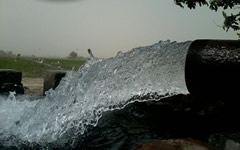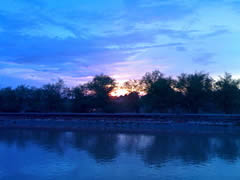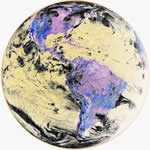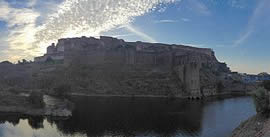Water: The Second Element
By Brook & Gaurav Bhagat

An enlightened mystic of this age, Osho, has proclaimed that the third world war can happen due to water-- or, rather, the lack of it. The statistics say the same thing: as the share of fresh water per person decreases globally, and the population demanding it increases, there are bound to be conflicts which, as history dictates, can lead to military action and, ultimately, even a world war.
As the world population surpasses 7 billion, underground water levels are falling on every continent, most people on Earth are not getting enough water for the basic necessities of life. Rivers are drying up before they reach the sea, and plants and animals are undoubtedly suffering too.
China, India, and the U.S. claim half the world's population, and provide half of the global food supply as well. In the past, irrigated farming has been plagued with problems like waterlogging, salting, and silting. Now, thanks to science and technology, there is another price to be paid-- it is possible to dig ever deeper for water with more powerful pumps, but the cost is aquifer depletion.
Hydrologists define a country as suffering "water stress" when the amount of fresh water per person drops below 1,700 cubic meters per year. In recent times the number of people facing water stress has reached almost one billion, which will increase to 3 billion by 2025 according to the current trend of growing population. This means people affected by water stress will not get enough water for their daily life-- cooking, drinking, bathing, etc.
 Photo: Nirupam Gyan
Photo: Nirupam Gyan In India, where one-sixth of the world population is living, the water acquired by underground pumps is twice as much as the aquifer recharge from rainfall. The well-known international water research group, International Water Management Institute, has estimated that the grain harvest of India could be reduced by up to 25% as a result of aquifer depletion. In a country which is producing 18 million people per year-- as much as the entire continent of Australia-- this is, for some, a death sentence.
Other than the Eastern states and the Southwestern coast, which get 300-1000 cms (120-400 inches) of annual rainfall, most of the Indian regions are getting rain under 40-300 cms (16-120 inches) annually. The driest regions are Western Rajasthan and a few parts of Gujarat, receiving 0-40 cms (0-16 inches) of yearly rainfall as well as Leh in Kashmir. Snowfall is limited to Himalayan mountain range, whose runoff provides valuable water for most of the country's rivers. As an estimate India receives 70 cms (28 inches) average annual rainfall.
By the time the Ganga (Ganges) River reaches the Bay of Bengal, in the dry season, it is severely depleted, leaving little for Southeastern farmers. 90% of the rain in the Gangetic plains is not harvested or used, and flows into the Bay of Bengal.
India receives 420 million hectare- meters (mham) of water each year: 400 mham from precipitation and the remaining 20 mham as surface water, coming from rivers outside the country. At least 40% of this water is flowing out to sea and to neighboring countries.
In 1955, India's per capita water availability was 5,300 cubic meters (cu.m.). Currently this figure is only about 2000 cu.m., as compared to the global average of 7,420 cu.m and, in Asia, 3,240 cu.m. Statistics say that by the year 2025 the number can drop as low as 1500 cu.m. due to rising population levels, urbanization and systemic abuses of water.

If more rain is harvested, and more efficient methods of rain harvesting are implemented, the 40% of water that is flowing unused from the country can be utilized, as well as lessening the risk of floods and national problem of water stress.
The ancient ways of harvesting rain were quite efficient. Water was everyone's business, unlike the present age, when, in towns, water is simply expected to flow from the tap, and if it doesn't, it is the fault of city corporations run by the government. A few of these ancient ways are still practiced in villages, without any new energy or developments.
The main traditional method of rain harvesting in India is Talab or Kundi. This way is easiest, as any open place with diameter near about 100 meters or more can work for it. The land is sloped towards the center which can be cemented or lined with limestone to support the rain water flow in the middle, where a well lies. Covering the well from the top is also beneficial as it keeps the water clean and protects it. Even with only 10 cms (4 inches) of rainfall, as in Jaisalmer district right in the heart of the desert in the Westernmost state Rajasthan, 1 million liters of water are available year-round.
One other good example of this method of rain harvesting is the 500-year-old fort of Chittor in Rajasthan, where the builders of this fort made tanks to save the precious rainwater. It was built on a good height where the people living in the fort did not have access to the town's groundwater or any streams. Yet, the tanks were so efficient that the fort never ran out of water, even though the town did in drought years.
In Jodhpur, the second largest city in Rajasthan, there are several talabs. Two, Ranisar and Padamsar, were also made over 500 years ago, by the builders of the famous Meharangarh Fort, and rarely run out of water.
Water harvesting has traditionally meant valuing the raindrop, and being continuously conscious of water conservation in daily life; this value has grown back in many residents of Chennai. The simple urban rain harvesting system they are using there is quite low in cost. The water falling on the roof of the buildings is collected and stored in a ground-level well via pipelines. This well can generally provide water around the year. The water in the well is being cleaned before pumping by alum, which is good enough for drinking and cooking. Water used for bathing and washing clothes is drained into another storage sump after being subjected to organic treatment. About 40% of this water is used for flushing toilets and the rest is used to water the gardens. This new move has made these people free of water shortages and the Chennai Municipal Corporation has made it mandatory for all new buildings to install this low-cost system.
Another large-scale method for the conservation and distribution of water is to build dams and canals. 9% of the world's large dams, according to the World Commission on Dam Report 2000, are Indian, numbering 4291; 3596 (73%) of these dams are located in the three Western agricultural states, one of which is Rajasthan.
One of India's most remarkable examples of water management is Rajasthan Nahar (canal), now known as Indira Gandhi Nahar Pariyojna (canal project) or IGNP. In a state where the annual rainfall is just 10-65 cms (4-26 inches), fresh water is precious thing.
The creation of IGNP commenced in 1958, and construction and expansion of the canal system continue today. Its aim is to use approximately 90% of the surplus water of Ravi and Byas rivers, which are fed by runoff from the Himalayas. The construction of IGNP was planned in two stages. The total length of the main feeder and distribution canals is currently about 7000 kms.

Although the funds invested in IGNP in the last ten years alone total almost 32000 million Rupees, the benefit-cost ratio is near 3:1, calculated on the basis of annual agricultural production. 1500000 ha land is being irrigated due to IGNP, which is about 8% of the total sown area of Rajasthan.
Yet the unconscious behavior of human beings is destroying the natural balance. Global warming, pollution, the decay of the Ozone layer and deforestation etc., all cause the snowfall over the Himalayan region to be severely affected (sometimes greatly increasing and vice versa), which is the source of most of the Indian rivers. The result of this is the endangerment of human, plant and animal life, either by drought or by flooding.
Trikal, meaning a drought of three consecutive years, is what the state of Rajasthan now faces; other parts of India also share this condition. This year's meager "rainy season" could hardly have been called such-- in certain areas the rainfall was the lowest it has been in 100 years. The effects of such a drought are widespread, causing scarcity of drinking water, inflation due to poor crop yields, and even severe rationing of electricity due to the sinking water table. This year's warm winter temperatures, as of December 20, broke records of 150 years.
Many Rajasthani towns and cities, now in a state of emergency, are forced to rely on the government's reallocation of drinking water via tankers and water trains, and the quality of drinking water has in some areas decreased as well, causing illness.
Long-term solutions to the Indian and essentially global water crisis include tackling the problem of overpopulation in order to decrease the demand for water. In addition, not only new ways of water conservation are needed, but in fact the old ways of water consciousness, of recognizing the true value of what makes up not only 70% of our planet, but up to 80% of our own bodies: water.
The sacred nature of water in Indian consciousness is well-known, but a shift in viewpoint is essential: the obvious example is the Ganga (Ganges) River, famous for being simultaneously the world's holiest and most polluted body of water. Rather than seeing water as a purifying element to be used and thrown away, it must be understood to be as precious as life itself.
Did you like the article? Subscribe here to our New Article Email Alert or RSS feeds.
Sharing is caring! Don't forget to share the love, and keep the conversation going by leaving a comment below:
Advertisement

 Photo: JBy Nkansara (Own work) [
Photo: JBy Nkansara (Own work) [